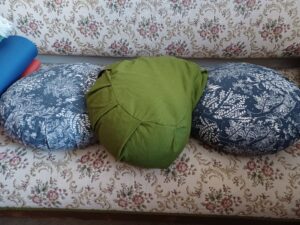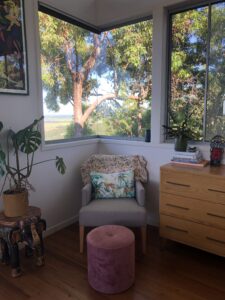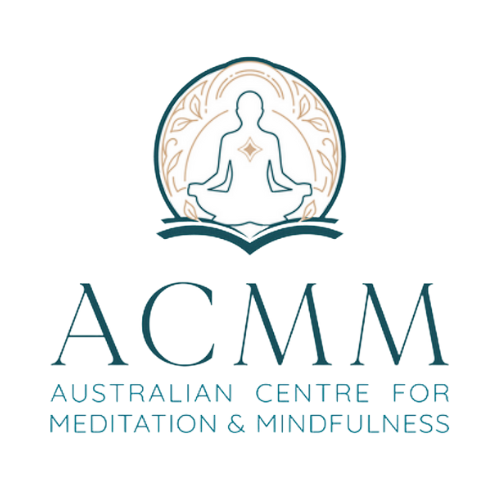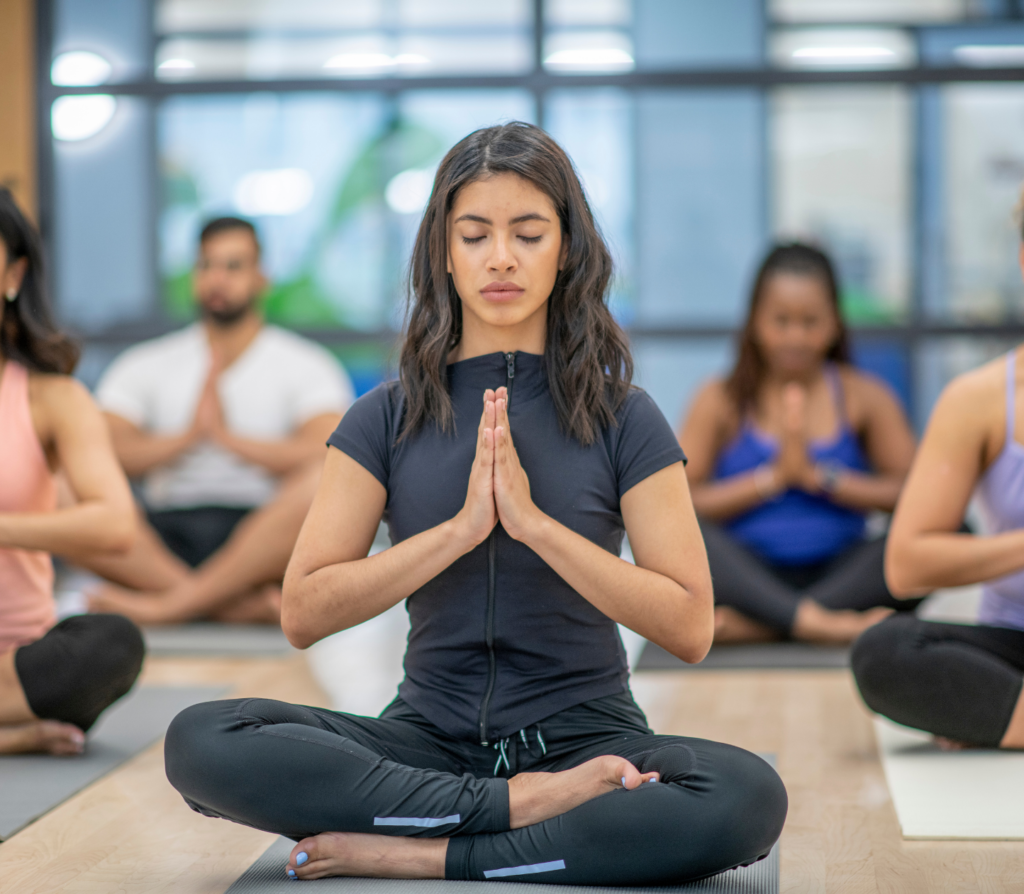Sitting, lotus position, half lotus, lying down, standing, walking, chairs, cushions. With so many meditation postures to choose from, we asked our ACMM coaches to share how they choose a meditation posture. Continue reading to find out their preferences, tips and recommended props! What we discovered is that everyone is an individual. Do what works for you!
Tip Number 1: Mix it up!

“On the meditation cushion, the couch, on the bus, lying awake in bed, when walking, eating, making a cup of tea, when talking with a friend, getting work done, doing the dishes . These are all great opportunities to return to and experience life as centred presence. In terms of formal practice, I tend to sit on a mat and cushion with my hands facing down on my thighs in Gyan mudra. – ACMM Coach Jen Hill
“I meditate in a few main formal meditation postures:
- ½ lotus in nature on ground
- ½ lotus on a cushion
- Sitting on a chair
- Laying down
- Walking
- Standing” – ACMM Coach Tim James
“The Meditation posture that I use is usually sitting, cross legged on a round cushion, with hands in my lap or palms up, on my knees. I use a variety of different cushions. Sometimes I will get my students to lie on their yoga mat with a cushion under the head if doing a relaxation meditation.” – ACMM Coach Brea Willingham
Tip Number 2: Listen to your body
“At different ages and stages of my life I have experimented with all sorts of meditation postures including cross legged on the floor, sitting on a chair and lying down. Not to mention moving meditations. I encourage people to listen to their own bodies and direct experience since they are the expert on their bodies. There are so many reasons these days why having a flexible approach to meditation position is important. From compassion for the parts of us that experience restriction, fatigue and/or pain to inclusivity of all diverse bodies and needs . Let go of attempting to adhere to traditional or idealised ways of sitting that might be unattainable or exacerbate fatigue, pain or injuries.
In my own practice I listen and respond to what my body needs, knowing that my needs change. What I have learned over time is to be willing to give up an ‘ideal’ sitting position for instead accepting my body’s needs. Think of what would feel most supportive in that moment for my body and intention for the practice.” – ACMM Coach Morgan Jai Morincome

“It depends on the length and type of meditation. If the meditation is longer than 30 minutes, I make sure I sit in a chair, have back support or lie down when needed. I have always suffered from tight hips which has resulted in some pretty painful meditation experiences. I remember attending a Vipassana meditation retreat. By day 3, I was sitting on a mountain of cushions trying to remain sitting cross-legged. Which makes me laugh at how that must have looked!. I felt so ashamed that I couldn’t sit in the ‘traditional’ position. Eventually, I surrendered to my body’s limits and sat in a chair at the back. The bliss! I now relish the feeling of honouring my body by choosing a comfortable and supportive meditation posture.” – ACMM Coach Lauren Howe
Tip Number 3: Allow your position to change
“For me sitting and laying sometimes transform into body movement or repositioning into one of the other mentioned positions and some not mentioned. Eg. Prayer position (head bowed with hands to heart, or head towards the ground if outside).” – ACMM Coach Tim James
“Sometimes I start sitting. Then may shift into a standing position for movement and finish lying down. It feels so empowering to flow with the energy of the meditation and my body” – ACMM Coach Lauren Howe
Tip Number 4: Any position is the perfect one
“Wherever I am is a great position for meditation. In the sense that my meditation these days largely involves simply coming back to myself, and resting in that centred, presence of awareness. This can be remembered and reconnected with throughout the day. No matter what I am ‘doing’. So whatever posture I am in is perfect for meditation.” – ACMM Jen Hill
“Informally meditation is an anywhere, everywhere practice too. So all positions involved in the human experience. Eyes open or closed.” – ACMM Coach Tim James
Tip Number 5: Choose a position based on your intention
“Usually, the position I choose to meditate in depends on two factors. The time of day and my intention for the practice . So I always think it’s a great idea to consider this before choosing a suitable position.
If it’s the morning and I would like to remain alert and not too sleepy to go into my day I meditate seated in a chair. I find this is the most comfortable seated position as I have amble back support. This position is great for awareness style meditation such as mantra or breathwork. Where my intention is to maintain complete awareness. I also find this position to be helpful for hurdles such as pins and needles and restless legs. If I meditate in the evening and I’m looking to unwind from my day and sink into relaxation. Then I usually meditate lying down. I find a yoga mat, blanket, and eye pillow to be supportive. Eye pillows are great for helping settle and soothe tired eyes.” – ACMM Coach Sammy Wynn
At ACMM, we offer Certificate, Advanced Certificate, and Diploma Training Options, with optional Business Development Support alongside and after your training.
Find out if our courses are the right fit for you. Book a Zoom Discovery Call with us today!





